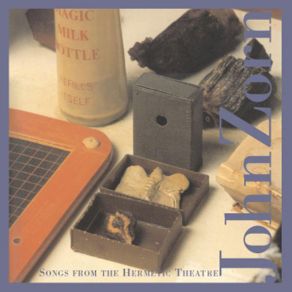Songs from the Hermetic Theater
Download links and information about Songs from the Hermetic Theater by John Zorn. This album was released in 2001 and it belongs to Electronica, Jazz, Avant Garde Jazz, Rock, Avant Garde Metal, Alternative, Classical genres. It contains 4 tracks with total duration of 51:13 minutes.

|
|
|---|---|
| Artist: | John Zorn |
| Release date: | 2001 |
| Genre: | Electronica, Jazz, Avant Garde Jazz, Rock, Avant Garde Metal, Alternative, Classical |
| Tracks: | 4 |
| Duration: | 51:13 |
| Buy it NOW at: | |
| Buy on iTunes $9.99 | |
| Buy on Amazon $9.49 | |
| Buy on iTunes $9.99 | |
Tracks
[Edit]| No. | Title | Length |
|---|---|---|
| 1. | American Magus | 14:08 |
| 2. | In the Very Eye of Night | 11:19 |
| 3. | The Nerve Key | 9:34 |
| 4. | Beuysblock | 16:12 |
Details
[Edit]While it's true John Zorn has made a career of being unpredictable and unboxable as an artist (and as a composer and instrumentalist), Songs From the Hermetic Theater is bound to even confound some of the faithful — to its composer's delight, I am sure. The four pieces collected here represent three homages to Zorn's actual and aesthetic mentors — Harry Smith, Maya Deren, and Joseph Beuys, and a couple of firsts (yes, amazingly enough, he hasn't done it all yet); all but one are performed by Zorn solo. The disc opens with "American Magus" for the late shamanic polymath Harry Smith who Zorn learn "alchemical synthesis" from earlier in life. It is Zorn's first ever work composed for electronics. He borrows heavily from Merzbow and Tetsu Inoue (who is also on Tzadik) creating huge washes of refracted sound played at dizzying speeds in varying, alien pitches — making Squarepusher seem like Popol Vuh. The entire work, over 14 minutes, is almost unbearable in its intensity with no space left unfilled. Percussion speeds, if indeed they can even be called percussions since they are literally just different electronic frequencies that are fragmentary yet incessant. "In the Very Eye of the Night" uses the voice of filmmaker Maya Deren to introduce this sound collage of electric bass, water, piano, glass bowl, wooden flute, and bass drum. After the short intro, a bass throbs an indeterminate yet constant pulse, distorting itself over the piece's duration as a kind of mutated drone as other elements enter and leave seemingly at random. The effect is strangely haunting as it undulates and then washes over the listener in waves. "The Nerve Key" is Zorn's first work for computer-generated music. Interestingly, it sounds like a mirror image of "American Magus," with all the submerged frequencies and sequences up front and center in the mix. Like Stockhausen and Pierre Henri and Luc Ferrari before him, Zorn creates a working method for the piece that is determined by the "instrument" after being manipulated by the composer. It's a compelling work full of squelches and buzzes, bleeps and hums. For whatever reason, its lower tones and more prominent distortion make for easier listening and create a more articulate view of Zorn's tonal and sequence concerns. The album ends with the masterwork "Beuysblock" for the provocative and profound artist, the late Joseph Beuys. "Beuysblock," featuring the multiple violins of Jennifer Choi, is a work composed entirely of ordinary or organic material juxtaposed with piano, maracas, and strings. Some of the other instrumentation employed in this process-oriented sound collage is tissue paper, tallow, dirt, bricks, razor, writing pad, mustache scissors, 78 rpm records, staple gun, nail clippers, hair, rubber ball, power saw, clothes pin, blood, and so on. Over 16 minutes in length, the work is dark, brooding, sometimes marginally violent, and full of mystery. (Try identifying which element is used when in this work and it will drive you crazy.) A trio of violins opens the work with a skeletal melody, and is joined by the elements before being assisted and arranged into movements by the piano. At each turn of the theme — a slight inversion of "The Man With the Harmonica" by Ennio Morricone — other music-making sound implements are introduced, creating a soundtrack of movement and disposable culture, a temporary music created from the viscera of human existence. It's the most moving and ethereal piece on the album, and ranks among Zorn's most beautiful works. Songs From the Hermetic Theater may not be every Zorn fan's cup of gasoline, but almost none of his records are: he's written so much for so many different kinds of musical groupings it's difficult to have an affinity for them all — but it is a thoroughly rewarding and enriching collection of new works. This set adds even more depth and dimension to an artist who has become unstoppable not only in his output, but in his vision for modern music.